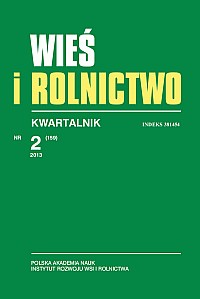The development strategies of dual profession holdings in region Bavaria – case study
DOI:
https://doi.org/10.53098/wir.2013.2.159/07Keywords:
dual profession holdings, Bavaria, instruments of public support, development strategyAbstract
The paper presents evolution and development strategies of ten Bavarian dual profession holdings. Bavaria, after the World War II, was characterized by fragmented agrarian structure and high share of population employed in agriculture. Intensification of agriculture, which took place in Western Europe in post-war decades, was observed also in Bavaria. But the effects were not so significant because of the regional policy which aimed in supporting small and dual profession holdings. Based on the literature analysis and on the in-depth interviews carried out with dual profession farmers, it was found that through the instruments of public support Bavarian dual profession holdings are quite stable. Their strategies aim to survive without any investments in growing or modernization. Despites high demand for agriculture land, this group of farmers do not plan resignation from agriculture activities and leasing out their land.References
Jahre Förderung: 10 Jahre Förderung der Landwirtschaft in Bayern. Grüner Plan und ergänzende Förderungsmassnahmen 1956 bis 1965, 1968. Schriftenreihe zur Landwirtschaftsberatung, Heft 12, Bayerisches Staatsministerium für Ernährung, Landwirtschaft und Forsten, München.
Bayerische Gemeinde- und Kreisstatistik 1949/50, 1952. Heft 177 der Beiträge zur Statistik Bayerns. Bayerisches Statistisches Landesamt, München.
Bayerische Gemeindedaten 1973, 1973. Bayerisches Statistisches Landesamt, München.
Bayerische Gemeindedaten 2004, 2004. Bayerisches Landesamt für Statistik und Datenverarbeitung, München.
Bayerischer Agrarbericht 2006, 2006. Bayerisches Staatsministerium für Landwirtschaft und Forsten, München.
Bayerischer Agrarbericht 2012, 2012. Bayerisches Staatsministerium für Landwirtschaft und Forsten, München.
Bergschmidt H., 1966: Das Wachstum der bayerischen Wirtschaft seit 1950 im Vergleich zum Wirtschaftswachstum in der Bundesrepublik Deutschland. München.
Der Agrarleitplan 1974, 1974: Bayern. Bauerland. Kulturland. Der Agrarleitplan. Bayerisches Staatsministerium für Ernährung, Landwirtschaft und Forsten, München.
Der Bayerische Weg. Agrarpolitik für eine bäuerliche Landwirtschaft und einen gesunden Lebensraum, 1978. Bayerisches Staatsministerium für Ernährung, Landwirtschaft und Forsten, München.
Der Einfluss der Flurbereinigung auf die Bewirtschaftung landwirtschaftlicher Betriebe in Bayern, 1989. Bayerisches Staatsministerium für Ernährung, Landwirtschaft und Forsten, München.
Gemeindedaten 1983. 1984. Bayerisches Landesamt für Statistik und Datenverarbeitung, München.
Görgmaier D., 1974: Moderne Agrarpolitik in Bayern im Rahmen der Pflege und Erhatlung der Kulturlandschaft. Harbeke Verlag, München.
Grässel G., 2001. Konzeption und Auswirkungen des Bayerischen Weges in der Agrarpolitik. Technische Universität Munchen, München.
Kornkruumpf M., 1948: Bayern Atlas. Landschaft, Anbau, Wirtschaft, Bevölkerungsbewegund. Leibniz Verlag München Bisher R. Oldenbourg Verlag, München.
Ländliche Entwicklung in Bayern, 2006. Bayerisches Staatsministerium für Landwirtschaft und Forsten, München.
Landwirtschaftliche Betriebszählung vom 22. Mai 1949 Heft 156a der Beiträge zur Statistik Bayern, 1953. Bayerisches Statistisches Landesamt, München.
Leffler C., Schall S., 1964: Materialien zur regionalen Wirtschaftsentwicklung in Mittelgebirgslagen der Bundesrepublik Deutschland – Bayerischer und Oberpfälzer Wald. Forschungsgesellschaft für Agrarpolitik und Agrarsoziologie e.V, Bonn.
Sawicka Z., 2013: Trajektorie rozwoju obszarów wiejskich Bawarii i Małopolski. Wydawnictwo Naukowe Wydziału Zarządzania Uniwersytetu Warszawskiego, Warszawa. DOI: https://doi.org/10.7172/2013.wwz.1
Seidl A., 1995: Deutsche Agrargeschichte. Fachhochschule Weihenstephan, Freising.
Siebert H., 2005: The German Economy beyond the social market. Princeton University Press, New Jersey. DOI: https://doi.org/10.1515/9781400851652
Statistisches Jahrbuch für Bayern 1952, 1952. Bayerisches Statistisches Landesamt, München.
Thiede G., 1990: Landwirt in Europe. Kontraste in den EG-Regionen. DLG-Verlag, Frankfurt (Main).
Schlögl A., 1954: Bayerische Agrargeschichte. Die Entwicklung der Land – und Forstwirtschaft seit Beginn des 19. Jahrhunderts. Bayerischer Landwirtschaftsverlag München.
Würfl P., Dörfler J., Rintelen P.M., 1984: Die Einteilung Bayerns in die Landwirtschaftliche Stnadorte, Landwirtschaftliche Erzeugungsgebiete und Agrargebiete. Bayerisches landwirtschaftliches Jahrbuch 61 Jahrgang, ¾.
Wüst H., Pelhak J., 1986: Das Gesetz zur Förderung der bayerischen Landwirtschaft. Kommentar. Kommunalschriften- Verlag J. Jahle, München.
Downloads
Article file downloads
Pages
How to Cite
Issue
Section
License
Copyright (c) 2013 Wieś i Rolnictwo

This work is licensed under a Creative Commons Attribution 4.0 International License.










